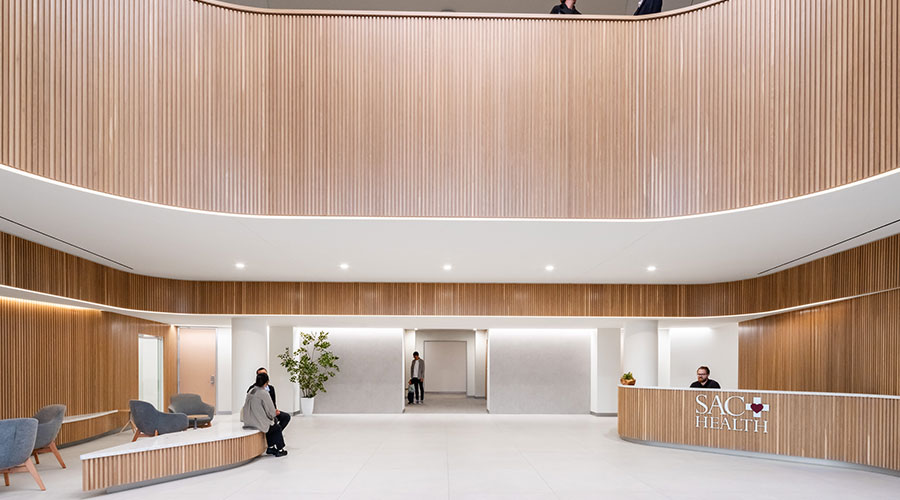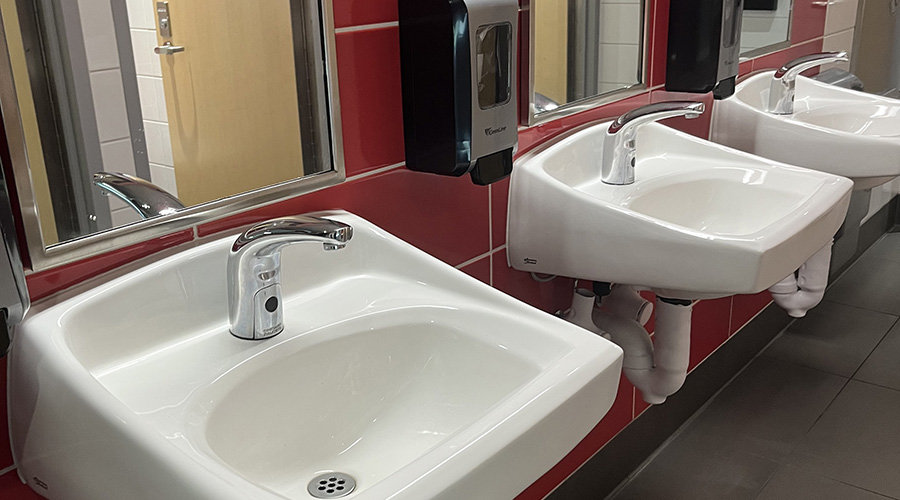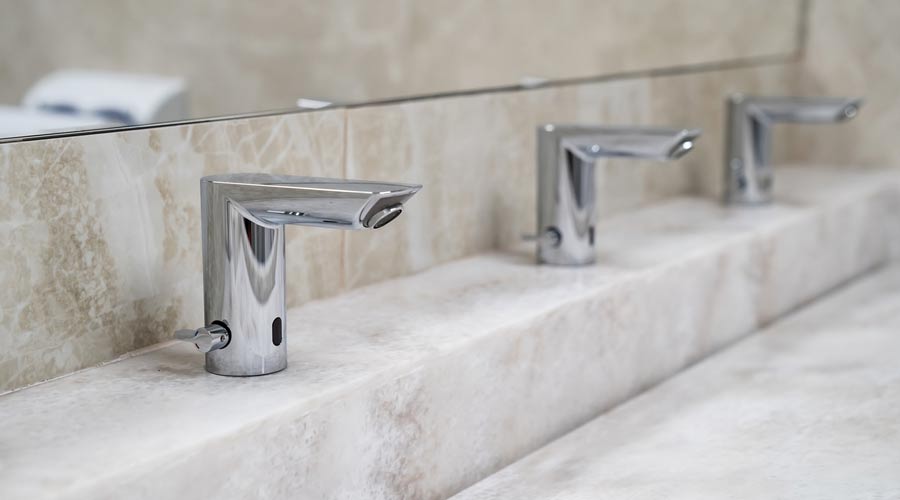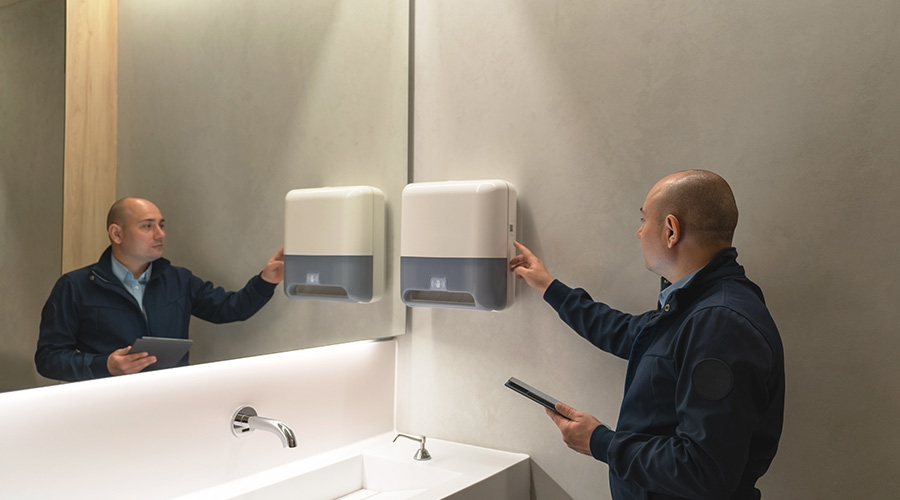Restrooms
Are Poor Product Choices Draining Your Budget?
If first costs were no object in the restroom design process, it’s safe to say that facility executives would choose long-life fixtures, surfaces and finishes that are easy to clean, and dispensers that do not require frequent restocking. Long-term maintenance costs of restroom facilities always exceed first costs, no matter what is spent on the design.
The problem is that first costs are always a major consideration. And the products that reduce operating and maintenance costs almost always have a higher first cost. To reduce long-term costs without breaking the construction or renovation budget, facility executives must find a balance between the two. Achieving that balance early in the design process is particularly important given the 20 to 25 year service life for the typical restroom.
The three biggest components of restroom operating costs are cleaning, water use and consumable supplies. If life-cycle costs are to be minimized, the restroom design must focus on ways to simplify cleaning, minimize water use, and reduce both the use of and the need to replace supplies within the restroom.
The materials chosen for the restroom will have a large impact on restroom cleaning costs. While low-use restrooms are typically cleaned on a daily schedule, high-use restrooms may require cleaning every two to four hours. Over the 20 to 25 year life of the restroom, these cleaning costs rapidly add up, often exceeding the total first costs for the restroom. For that reason, even slight modifications in the restroom design that result in reduced cleaning costs will have a significant affect on the life-cycle cost of the restroom.
For example, light-color countertops are much better at hiding water stains than dark countertops. As a result, dark countertops will require more frequent cleaning to maintain the same appearance. Similarly, surfaces that have a high-polish finish more readily show dirt and stains and therefore will require more frequent cleaning.
Medium to dark tone ceramic floor tile also tends to hide soils and stains and therefore will require less frequent cleaning. Using large tile will minimize the amount of grout required, thus easing the task of cleaning the floor. Providing a positive slope towards multiple floor drains in the restroom will further ease the task of cleaning the floors. Selecting fixtures, including toilets, urinals, partitions and trash cans that are attached to the walls or ceilings rather than the floor will also reduce the amount of time required to clean the floor.
Whether it’s an office building, an educational facility, a hospital or a hotel, restrooms account for nearly one-half of the total water use for the building. With annual water and sewage costs increasing at nearly double the rate of inflation, it is critical that the restroom facility be made as water efficient as possible.
Reducing Water Use
The Energy Policy Act of 1992 established standards for maximum flow rates for restroom fixtures. While the standards provided a dramatic reduction in water requirements, they should be considered the minimum standard for any fixture being installed. Advances in fixture designs have resulted in ultralow-flow devices that can easily exceed the standards. All restroom designs, especially those serving high-traffic-volume facilities, should invest in these ultralow-flow fixtures.
Water requirements can be further reduced by installing electronic controls on all flow devices. These controls, with their metered flow and positive shutoff control, are an effective way of providing users with adequate water flow while ensuring that the flow is turned off when it is no longer needed. Touchless faucets that limit water flow using sensor technology have been shown to reduce faucet water use by 50 to 80 percent over manual controls. Electronic flush valves, by metering the quantity of water per flush, also reduce water use on average by 50 percent. While the valves carry a higher first cost, they typically pay for themselves in three to 12 months. Touchless electronic controls provide an additional benefit of improved sanitation.
Electronic controls can be powered by low-voltage wiring or by batteries. The former are best suited for new construction or major renovation projects. Battery-powered controls are best
suited for retrofit in existing facilities due to ease of installation. Their primary disadvantage is the need to change the batteries. In high-use facilities, batteries may have to be changed every two to three months. In average use-facilities, battery life typically is one to two years. A new generation of battery-powered controls uses a solar cell driven by ambient light to keep the battery charged.
The use of electronic controls can reduce maintenance requirements in the restroom. Manual flush and faucet valves are high-use, high-maintenance items that are subject to frequent abuse by users. By replacing manual valves with electronic touchless valves, the amount of wear and tear on the system is greatly reduced.
Restroom Supplies
Consumable supplies needed to service the restroom, paper products and soap, for example, also contribute to the life-cycle costs of the restroom. These costs include the labor needed to restock the restroom as well as the supplies themselves. In this case, minimizing life-cycle costs starts with the selection of the dispensing fixture.
To minimize the use of consumable supplies, select dispensers that limit the amount of product dispensed. For example, there are paper towel dispensers that are touchless and automatic in operation. When activated, a set quantity of paper towels is dispensed. A time delay built into the dispenser’s controls prevents a second dispensing of towels for a set period of time, thus preventing users from taking larger quantities of towels than are actually needed. This reduces both the amount of product used and the frequency of restocking. Over the service life of the dispenser, the savings are significant.
Another factor that affects the cost of consumable supplies and the labor needed for restocking is the quality of the product. Here again is an issue of first costs weighed against operating costs. The least expensive product is not necessarily the lowest cost option. For example, if the quality of an inexpensive paper product is such that users feel they must double or triple the amount of product used, then savings can be had by using a higher quality, higher cost product.
The life-cycle costs of consumable supplies and their dispensers can also be significantly affected by where they are placed in the restroom. Surface mount units are subject to accidental damage or vandalism by users. Using recessed units reduces the chances for damage simply by getting the fixtures out of the way.
Although life-cycle costs of restroom finishes and components are a major factor in their selection, other factors must also be considered that may or may not conflict with life-cycle cost calculations. Of these factors, the one that most frequently overrides life-cycle costs is aesthetics. With careful planning facility executives can have a restroom that is both attractive and cost-effective.
ANALYSIS
Understanding Life-Cycle Costs
The life-cycle costs for restrooms components include the initial purchase and installation costs plus all costs associated with operating and maintaining those components over their service lives. How they are calculated will vary from component to component, but if long-term costs are to be minimized, they must be calculated for each major component being installed in the restroom.
Start by considering the needs of the users. Different applications place different demands on restroom facilities. In general, there are three major restroom application categories: high-demand facilities, high-profile facilities and high-abuse facilities. What works well in one may perform poorly in another.
Restrooms in high-demand facilities must accommodate high volumes of people. For these facilities, fixtures and finishes must be selected on the basis of ease of maintenance and ease of cleaning.
High-profile facilities — such as corporate headquarters or upscale restaurants, retail facilities, and hotels — require materials and finishes that support the image that the facility is trying to project. Even the restroom layouts, with their typical high ceilings, wide aisles, and fixture separation, help project an image of luxury.
Facilities with the risk for high abuse, such as middle and high schools, will require layouts that allow for monitoring of activities within the restroom. Materials and finishes must be selected with an eye towards those that resist vandalism, from markers to physical abuse.
For each component or finish being considered, calculate life-cycle cost by determining the installed cost for the option, estimating its service life based on the projected level of use, identifying its operational and maintenance costs on a daily or weekly basis, and figuring out the cost to remove the item at the end of its service life.
Component service life is an important factor to consider when evaluating options for fixtures and surface materials. Most materials come with a standard service life rating provided by the manufacturer. Those ratings, however, are for applications where the products will be exposed to only normal levels of wear and tear. Those ratings have to be modified for applications with high-volume traffic or the potential for abuse. For example, a good quality ceramic tile floor has an expected service life of 20 to 25 years when exposed to routine traffic flows. That same tile, when installed in a high traffic restroom like those in airport terminals, will have a service life that is closer to ten years. Failing to modify a manufacturer’s rated service life based on the conditions that exist in a particular application will lead to unrealistic expectations and inaccurate life-cycle cost calculations.
|
James Piper, PhD, PE, is a writer and consultant who has more than 25 years of experience in facilities management. He is a contributing editor for Building Operating Management.
Related Topics:











